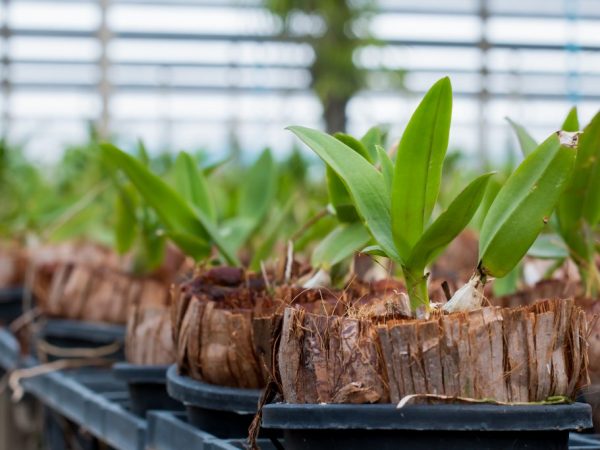Reproduction of phalaenopsis at home
Reproduction of the phalaenopsis orchid is a process that requires knowledge of agricultural technology, adherence to a number of rules and utmost care. Before you start propagating epiphytes, you should get seedlings. The transplanted phalaenopsis needs to be naturalized and properly cared for.

Reproduction of phalaenopsis at home
The main methods of breeding
Phalaenopsis orchid reproduces:
- seeds;
- roots (dividing the bush);
- cuttings;
- lateral processes (children).
Reproduction of the phalaenopsis orchid at home begins with the choice of a method for obtaining planting material. The longest and most laborious process is the propagation of phalaenopsis by seeds, and the most effective - by cuttings. In the latter case, after a short time, the epiphyte will please with a peduncle shoot.
Rejection by children
It is easiest to propagate the phalaenopsis orchid with children. They are produced by epiphytes that have reached the age of 3 years. Children appear on a flowering branch. They look like a thickening of the stem. A leaf emerges from this bulge as soon as the orchid finishes flowering.
The epiphytes to be transplanted must have one adult leaf and the rudiment of the second. These seedlings are the strongest, so pruning does not harm them or the mother bush.

It is easiest to propagate the phalaenopsis orchid with children.
A step-by-step guide for the reproduction of the phalaenopsis orchid by children looks like this:
- fill the container with a high-quality substrate;
- prepare sifted charcoal or grind several tablets of activated carbon into powder;
- disinfect scissors or a scalpel with medical alcohol or warm up over a fire and cool;
- make an incision at a distance of 5 cm below the bud with a leaf and 3 cm below the peduncle;
- sprinkle the cut with ash or coal.
The cut off plant is transplanted into the ground and watered abundantly from a watering can with warm water. After that, the flower is covered with a glass jar or glass. This allows you to retain moisture and prevent a drop in air temperature. Also, the glass jar diffuses the sun's rays.
Subsequent care for phalaenopsis consists in ensuring regular watering and protecting the seedling from direct sunlight. Evidence that the shoot has taken root is the appearance of an aerial root.
Division of bushes
Similarly to the previous method, the phalaenopsis orchid is reproduced by dividing the mother plant. The fused leaf rosettes or 2 (or more) processes should be separated.
Caring for an epiphyte that propagates by roots is similar to caring for a flower shared by babies. Caring for a seedling consists of the following actions:
- timely watering;
- protection from drafts and pests;
- ensuring a comfortable temperature regime.
Divided bushes take root quickly. After a year, they delight the owners with abundant flowering, after which they are subject to propagation by cuttings.

Reproduction of the phalaenopsis orchid can occur by dividing the mother plant
Cuttings
Propagation of phalaenopsis orchids by cuttings is the most difficult of all methods of propagation of epiphytes and requires skills in working with flowers, however, it is this method that gives the best planting material. Using cuttings, the maximum number of shoots is obtained from one donor epiphyte.
Cuttings do not have roots before planting in the substrate, the layers are germinated. It turns out:
- Mini greenhouses. These devices allow you to recreate natural conditions, so reproduction in this way has the greatest efficiency. Sawdust of coniferous trees or sphagnum moss is used as a substrate. You can get the first shoots in 15 days.
- In water. The shank for this method is taken from the peduncle. Water for germination is poured into a transparent plastic bottle without a neck. To disinfect water and activate growth, a tablet of activated carbon or a pinch of cinnamon powder is dissolved in a liquid. A branch is taken about 10 cm long and with one bud. The stalk is immersed in water by a third. The liquid and bottle are changed every 3 days.
- Dry method. The method consists in dissecting the cutting and subsequent processing of the cut with hormonal cytokinin paste. In this place, the kidney is born after already 10 days. The use of this drug is strictly dosed, since the excess of the amount awakens the flower bud.
Special Requirements
Propagating phalaenopsis at home is easy if you follow some rules.
- The best time to breed is at the end of winter.
- For better growth, plant illumination and a high greenhouse temperature (27 ° C) are required. The optimal daylight hours for seedlings are 14 hours.
- Young seedlings and donor epiphytes should be protected from drafts. Greenhouse conditions for orchids are provided before roots appear.
- A prerequisite for the collection of cuttings is the cessation of flowering and the absolute health of the epiphyte. Otherwise, the mother plant weakens and dies.
Top dressing of plants transplanted to a permanent place is carried out no earlier than after 30 days, regardless of the method of obtaining planting material. The main watering is carried out as the substrate dries out.
Conclusion
Reproduction of phalaenopsis orchids at home is a complex process. Seed propagation is not possible for everyone, because you need not only to pollinate the flower, but also to be able to collect the seeds. It is easy to propagate an orchid with children from the buds, but the latter appear only after flowering.
Propagating phalaenopsis by cuttings is troublesome, but this method guarantees an excellent result, therefore, flower growers most often use the cuttings technique. An orchid grown from a cutting pleases with flowering after 3 years.


